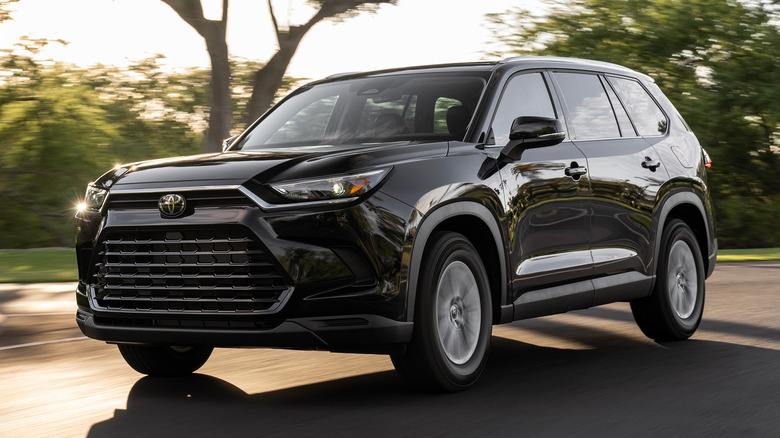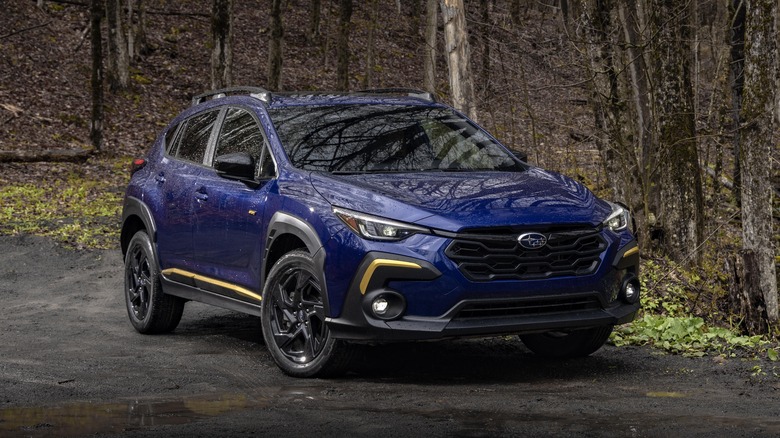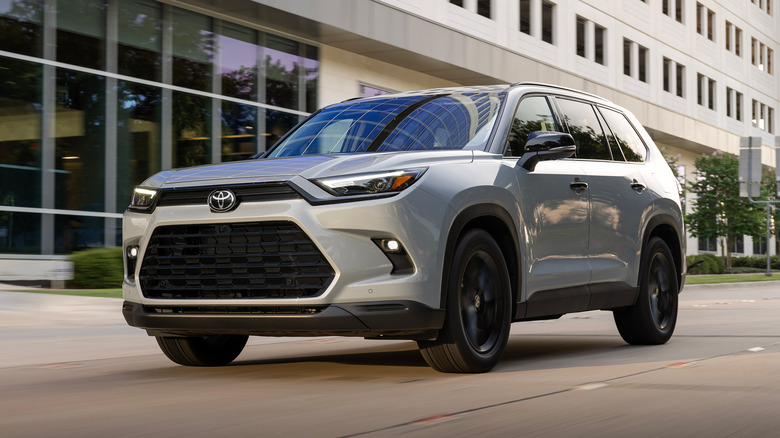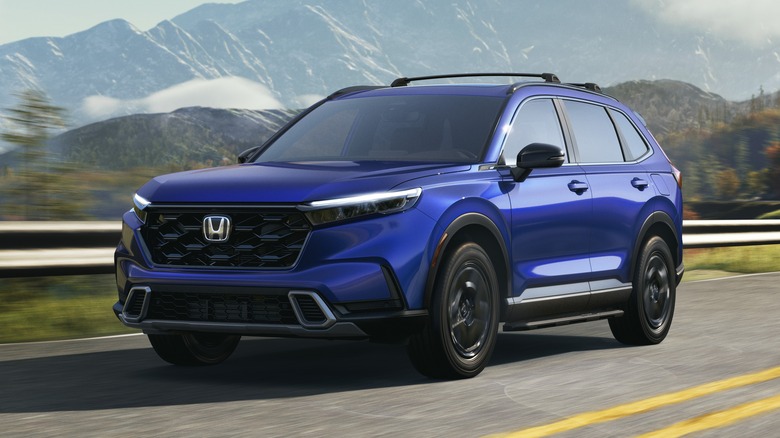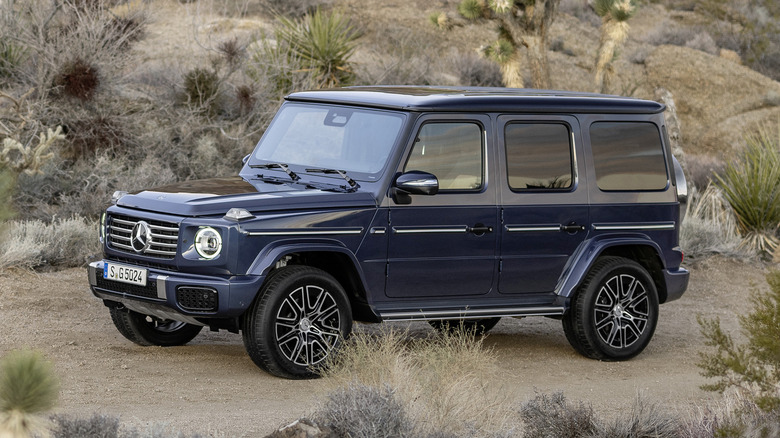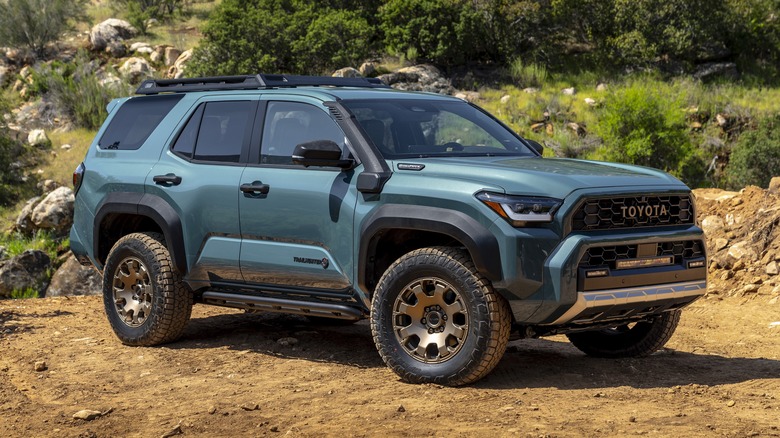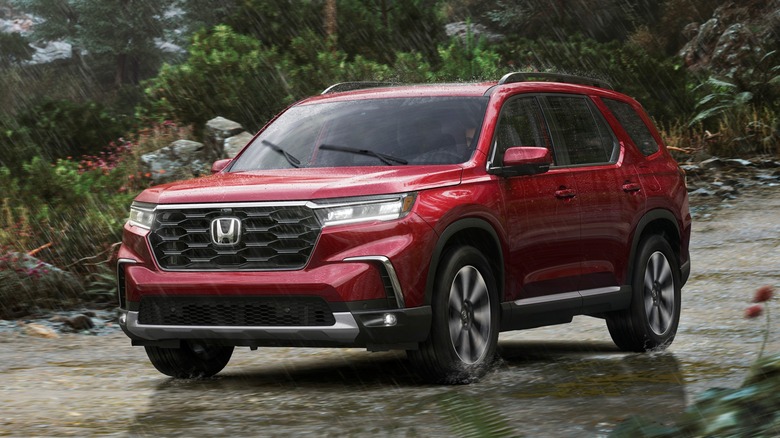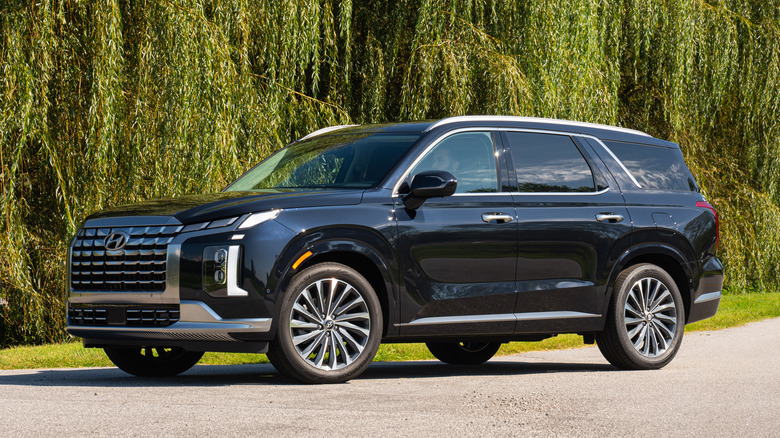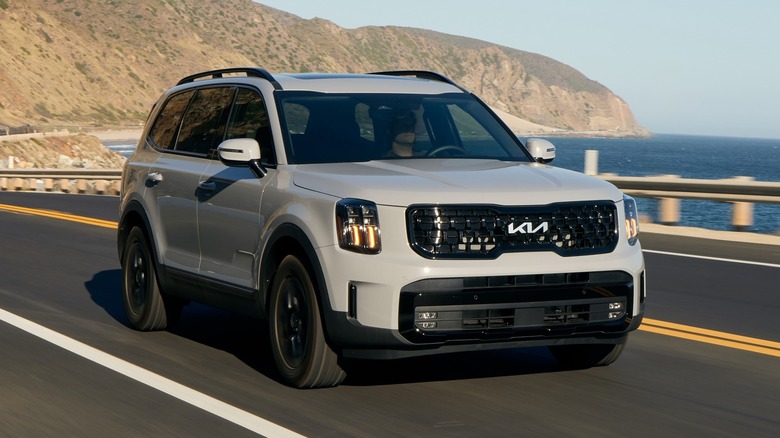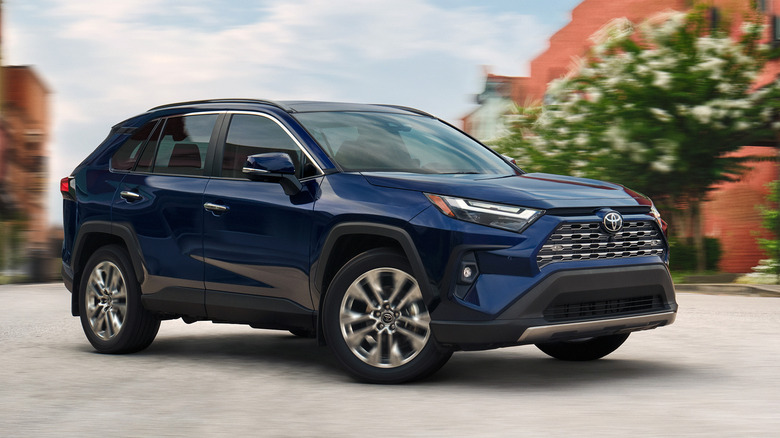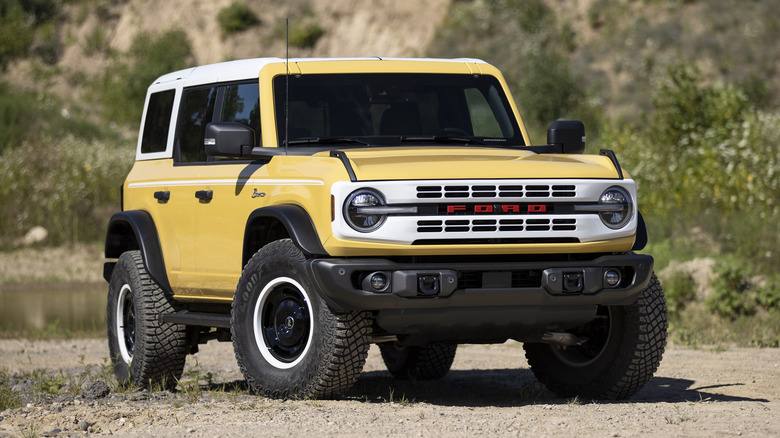These High-Resale Value SUVs Are A Smart Buyer's Best Bet
Buying a new car comes with a few inherent downsides. Suddenly, you become a lot more conscious about door dings, stone chips, and interior scuffs. Finding the right setting on the car's infotainment system isn't as intuitive as it once was, and squeezing the car into tight spaces becomes a more stressful process than before. Of course, all these minor inconveniences pale in comparison to the biggest new car downside: depreciation.
New cars will almost invariably lose value as soon as they're driven off the dealership lot, and will continue to lose value every mile they're driven and day that they're on the road. The average car will be worth 42.4% of its value after five years according to data from KBB. However, not all cars lose value quite so fast. In fact, some new cars significantly outperform the rest, and can retain over 50% of their value after half a decade of use.
Buyers looking for a new SUV that retains its value better than most aren't short on choice, since top performers can be found in a wide variety of segments. Using valuation data from KBB, SlashGear identified the best SUVs for value retention across the SUV spectrum, from six-figure luxury off-roaders to budget-oriented family haulers.
Subaru Crosstrek – 52.3%
The Subaru Crosstrek is offered in a variety of flavors, from the everyday base-spec variety to the off-road oriented Crosstrek Wilderness that SlashGear tested earlier in 2024. Subaru's smallest crossover SUV is — in its cheaper trims at least — designed to be an affordable entry point to the brand's SUV range, and starts from just over $25,000 excluding destination fees. That makes it one of the cheapest cars in its segment, and as a bonus, buyers get the peace of mind of knowing that the Crosstrek retains its value over time too.
According to KBB, the Crosstrek should be worth 52.3% of its original sticker price after five years on the road, placing it comfortably ahead of the average new car. Other Subaru SUVs like the Forester and Ascent might provide superior cabin space or increased all-terrain capability, but for value retention, the Crosstrek remains top of the table among its lineup siblings.
Toyota Grand Highlander – 53.3%
Designed for families that might find a regular three-row SUV too cramped, the Toyota Grand Highlander is spacious across every row and offers plenty of luggage capacity too. That added space comes at a cost, with the top Hybrid Max Platinum trim costing almost $60,000. However, buyers should find that the Toyota holds on to much of that value when it comes time to resell, with KBB predicting a 53.3% value retention rate over five years.
Aside from its cabin space, most other elements of the Grand Highlander are standard Toyota fare. That's no bad thing — the brand's Safety Sense suite of driver assistance technology is well equipped and comes standard on all trims, while the cabin is thoughtfully designed even if it's not the most exciting design in its segment. Buyers without a large family to transport might find better value — and similarly high value retention — elsewhere in Toyota's SUV range, but for those who need the space, the Grand Highlander is a highly competitive option.
Honda CR-V – 54.7%
There are several key choices to make when buying a Honda CR-V, since the model has a variety of powertrains and trims on offer. However, no matter which option buyers go for, the CR-V should be a safe bet when it comes to retaining value over time. The latest data from KBB estimates that the Honda should retain 54.7% of its value over five years, making it one of the top performing SUVs on the market in any segment.
Resale value is far from the only reason buyers gravitate towards the CR-V — its clean styling, frugal hybrid powertrain, and competitive asking price all further contribute to its appeal. The CR-V is also available with a long list of official accessories to suit all kinds of lifestyles, including surfboard attachments, bike mounts, and a six-person tent complete with Honda branding. And yes, the Honda tent looks way better than the Cybertruck's tent — although that was a low bar to beat.
Mercedes-Benz G-Class – 54.6%
Most luxury SUVs depreciate steeply over their first few years on the road, but the Mercedes-Benz G-Class is not like the rest. In fact, the opposite is true — the iconic off-roader holds its value better than most budget-oriented vehicles. KBB estimates that, after five years, a G-Class will retain 54.6% of its sticker price. Thanks to the G-Class' sky-high MSRP, owners are still losing a lot of money in dollar terms, almost $70,000 over the five-year term.
However, there are plenty of reasons why the G-Class is so expensive. Despite evolving considerably from its utilitarian roots, the G-Class has always retained its off-road abilities. It remains firmly among the best all-terrain vehicles in its class, even if most buyers will never take it too far off the asphalt. In G63 AMG form, the G-Class is also remarkably quick, with a 0-60 mph time that would trouble some sports cars. Buyers certainly get a versatile vehicle for their money, and for those who can afford it, it's a surprisingly sensible purchase in terms of resale value, too.
Toyota 4Runner – 57.6%
For the 2025 model year, the Toyota 4Runner receives a long-awaited overhaul, ditching the dated interior and aging bones of the previous generation in favor of an all-new design. The new 4Runner has been brought closer in line with the rest of Toyota's SUV lineup both inside and out, although it hasn't lost the rugged charm that buyers of the previous generation found so appealing.
As of this writing, KBB only has depreciation forecasts available for the 2024 model, but it seems unlikely that the new model will lose significantly more value than the outgoing car. A 2024 model is estimated to retain 57.6% of its value over five years, no mean feat considering the previous generation first debuted in 2009. The old-school construction of the last generation remained popular with buyers right up until its retirement, but with a choice of hybrid or gas powertrains, four-wheel-drive, and a plethora of off-road options available, there's plenty for 4Runner fans to like about this latest generation of the SUV.
Honda Pilot – 52.3%
Alongside the CR-V, another Honda SUV with high value retention is the three-row Honda Pilot. Both new and used examples of the Pilot remain popular with buyers for much the same reasons as the CR-V — it's practical, economical to run, and affordably priced. KBB expects the Pilot to retain 52.3% of its value over five years, which is well above the rate of the average new car.
The Pilot saw its last major refresh for the 2023 model year, with a more distinctive design, a revised range of trims, and some minor tech improvements. After spending some time with the car shortly after its launch, SlashGear found plenty to like, but thought the Pilot could have done with one or two standout features to set it apart from its competition. The three-row family SUV segment is a packed one, and although the car doesn't really put a foot wrong, it remains a sensible choice rather than an interesting one.
Hyundai Palisade – 53.7%
One of the Honda Pilot's many rivals is the Hyundai Palisade, which like its Japanese competitor, holds its value better than most. Data from KBB predicts that the Palisade should retain 53.7% of its sticker price after half a decade on the road, with the average five-year-old example worth just over $20,000. That's despite the fact that no hybrid option is available, with the V6 engine remaining unchanged across all trims.
Hybrids are an increasingly desirable option among buyers across all segments, but it seems buyers of the Palisade aren't too fussed about missing out on the electrification wave. After all, there are plenty of other ways the SUV makes a case for itself, with a spacious interior, attractive starting price, and Hyundai's usual generous helping of infotainment and safety tech. Plus, with up to eight seats available depending upon configuration, there's plenty of room for the whole family.
Kia Telluride – 52.6%
Built on the same platform as the Hyundai Palisade and sharing a powertrain, the Kia Telluride is another safe bet for buyers looking for an SUV that holds its value over time. It's forecast to retain 52.6% of its value over five years, according to KBB. SlashGear put the Telluride through its paces earlier in 2024 and found its interior to be particularly commendable, with the top-spec trim of our tester boasting a cabin that rivals entry-level models from German and Japanese luxury brands.
Its running costs are not so impressive, with the Telluride's only engine option being a 3.8L V6, much like the Palisade. As a result, the Telluride lags behind most of its competition in terms of efficiency, and doesn't benefit from the low-speed acceleration boost that most electrified models offer. It might cost more at the gas pump, but its competitive starting price and high value retention help offset that sticking point.
Toyota RAV4 – 50.6%
Buyers who opt for Toyota's best-selling RAV4 won't win any prizes for originality, but there's a reason the SUV remains such a common sight on American roads. It ticks all the right boxes for a sensible, affordable family SUV, including holding its value during its first five years on the road. Over that period it will keep 50.6% of its initial sticker value, per KBB. That reputation for sensibility and affordability makes it a popular choice both new and used, and with the launch of the latest generation, buyers have more powertrain choices than ever to boot.
Gas, hybrid, and plug-in hybrid options are available, although the latter comes with a notable price premium. A range of trims is also offered, from basic to premium, while the TRD Off-Road and Woodland Edition trims cater to buyers who are willing to sacrifice a little on-road refinement in return for all-terrain capability. Combine the RAV4's individual talents with Toyota's brand-wide reputation for reliability, and the result is an SUV that continues to be a favorite with buyers even with an increasingly packed field of competition.
Ford Bronco – 63.8%
Most of the top performers when it comes to holding value over time fall into one of two camps. The first are the sensible, highly regarded models that rely on their practicality and reliability to remain in demand with used buyers. Then, there are those models that simply rely on individual charm. The Ford Bronco arguably falls more towards the second category — it's difficult to justify buying one based on efficiency, space, or on-road manners, but that matters a lot less since it has so much personality.
Ford has released a number of special edition Bronco trims including the Bronco Heritage Edition, but the basic SUV remains mostly unchanged since it was first launched in 2020. That's because it doesn't need to change, as Ford got the formula just right the first time around. It looks unlike anything else on the market, blending modern and retro touches, and it can be a handful to drive on the road.
It's about as far from sensible or rational as you can get from most of the other family-oriented SUVs here, but it holds its value better than any of them. According to KBB, the Bronco will retain an exceptional 63.8% of its value over its first half a decade on (or off) the road.
